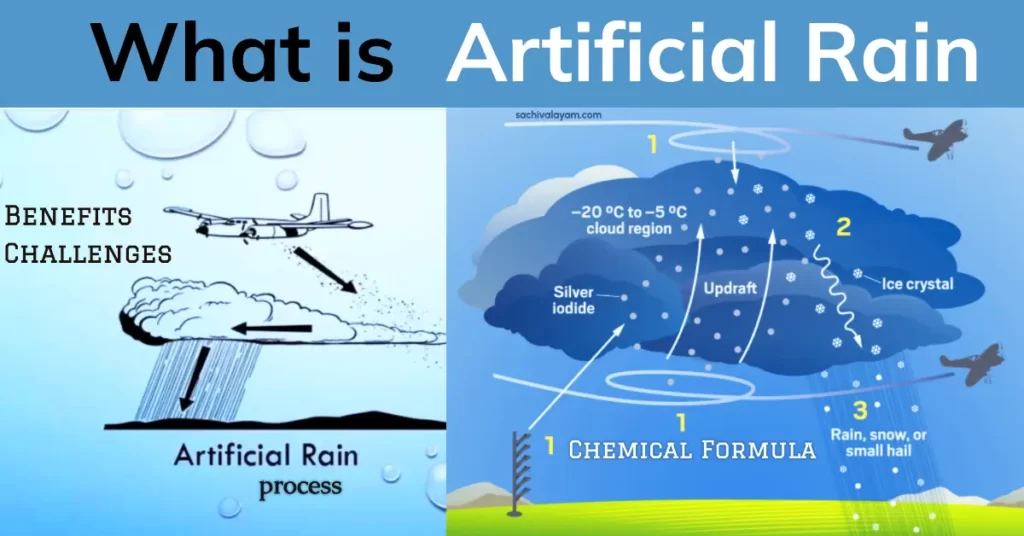Artificial rain is the process of inducing rainfall by dispersing artificial substances into clouds. This can be done using a variety of methods, including airplanes, flares, and ground-based generators. The most common artificial rainmaking substances are silver iodide and dry ice.
Table of Contents
ToggleArtificial Rain Chemical Formula
The two main chemicals used for artificial rain are dry ice and silver iodide.
- Dry ice: Dry ice is a solid form of carbon dioxide. Its chemical formula is CO2.
- Silver iodide: Silver iodide is a chemical compound made up of silver and iodine. Its chemical formula is AgI.
Dry ice is more commonly used than silver iodide because it is less expensive and easier to transport. However, silver iodide is more effective at seeding clouds.
How are dry ice and silver iodide used for artificial rain?
- Aircraft: Aircraft can drop pellets of dry ice or silver iodide into clouds.
- Ground-based generators: Ground-based generators can produce a mist of dry ice or silver iodide that can then be blown into clouds.
- Rockets: Rockets can be used to launch flares containing dry ice or silver iodide into clouds.
How does artificial rainmaking work?
Artificial rainmaking works by seeding clouds with tiny particles. These particles act as nuclei around which water vapor can condense. When the water droplets become too heavy to stay suspended in the air, they fall as rain.
The type of artificial rainmaking substance used depends on the type of cloud. For example, silver iodide is often used to seed clouds that are already producing some rain. Dry ice is often used to seed clouds that are not producing any rain.
Benefits of artificial rainmaking
- Improving water supply: Artificial rain can be used to increase rainfall in areas that are experiencing drought. This can help to improve water supply for drinking, irrigation, and other uses.
- Reducing drought: Artificial rain can help to reduce the severity and duration of droughts. This can save lives and property, and it can also help to protect ecosystems.
- Suppressing hail: Artificial rain can be used to suppress hail storms. This can protect crops and property from damage.
- Reducing fog: Artificial rain can be used to reduce fog. This can improve visibility for transportation and other activities.
Challenges of artificial rainmaking
- Cost: Artificial rainmaking can be expensive, especially on a large scale.
- Effectiveness: The effectiveness of artificial rainmaking can vary depending on the type of cloud and the weather conditions.
- Environmental impact: There is some concern that artificial rainmaking could have a negative impact on the environment. For example, some studies have shown that artificial rainmaking could increase the acidity of rain and snow.
Artificial rain in Delhi
Delhi is a city that is facing severe water scarcity. The city has experienced a number of droughts in recent years, and water levels in the Yamuna River have fallen to dangerously low levels.
The Delhi government is considering using artificial rain to increase rainfall in the city. However, there are concerns about the environmental impact and the cost of such a project.
Potential future applications of artificial rain
Artificial rain is a complex and evolving technology. It has the potential to be a powerful tool for addressing some of the world’s most pressing challenges. However, it is important to continue to research and develop artificial rain in a responsible and sustainable way.
Is artificial rain good or bad for you?
Potential benefits of artificial rain:
- Increased water availability for agriculture, drinking water, and other purposes
- Reduced risk of drought
- Improved snowpack for water storage
- Reduced hail damage
Potential risks of artificial rain:
- Environmental impact: Artificial rain can affect the chemistry of clouds and precipitation. This could have negative consequences for ecosystems and human health.
- Economic impact: Artificial rain can be expensive to implement and maintain. It could also lead to increased competition for water resources.
- Ethical concerns: Some people argue that artificial rain is interfering with nature and could have unintended consequences.
FAQ
Dry ice and silver iodide work by acting as nuclei for water droplets to form around. When water vapor in the air comes into contact with these nuclei, it condenses and forms water droplets. These water droplets can then grow large enough to fall as rain.
Yes, artificial rain is possible in India. In fact, India has been using artificial rain for decades.
The cost of artificial rain in India varies depending on the size and scope of the project. However, it is generally estimated to cost between Rs. 2-5 lakh per hour to seed clouds.
- Maharashtra government spent Rs. 30 crore on a cloud seeding project in 2019. The project was successful in increasing rainfall in the state by 10%.
- In 2023 Delhi government has estimated that the cost of implementing a cloud seeding project in the city would be Rs. 13 crore.
Dry ice and silver iodide
In general, dry ice is more effective in warmer clouds, while silver iodide is more effective in colder clouds. Silver iodide is also more effective in clouds that have less moisture.
Cloud seeding
Vincent J. Schaefer, a self-taught chemist


